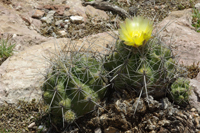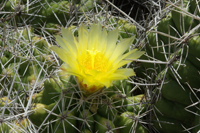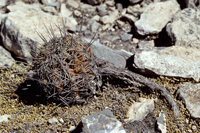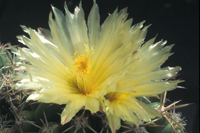Basionym: Echinocactus leucacanthus Zucc. ex Pfeiffer, Enum. Cact. 66 (1837).
Lectotype: Abh. Bayer. Akad. Wiss. München 2: Tab.II (1837), E.F. Anderson, Bradleya 5: 62 (1987).
Synonyms: Ferocactus leucacanthus N. P. Taylor Cact. Succ. J. Gr. Brit. 41: 90 (1979). Cereus maelenii Pfeiffer, Allg. Gartenz. 5: 378 (1837). Echinocactus maelenii Salm-Dyck, Cact. Hort. Dyck. 18 (1842). Mammillaria maelenii Salm-Dyck, Cact. Hort. Dyck. 14 (1845). Echinocactus maelenii Hemsley ('macleanii'), Biol. Centr. Amer. Bot. 1: 534 (1880). Cereus tuberosus Pfeiffer, Enum. Cact. 102 (1837). Echinocactus tuberosus Salm-Dyck ex Foerster, Handb. Cact. 287 (1846). Echinocactus leucacanthus var. tuberosus Foerster, Handb. Cact. 287 (1846). Echinocactus ehrenbergii Pfeiffer, Allg. Gartenz. 6: 275 (1838). Thelocactus ehrenbergii F. Knuth, in Backeb. & F. Knuth, Kaktus-ABC, 359 (1935). Echinocactus leucacanthus var. crassior Salm-Dyck, Cact. Hort. Dyck. 35 (1850). Echinocactus porrectus Lemaire, Cact. Aliq. Nov. 17 (1838). Thelocactus porrectus F. Knuth, in Backeb. & F. Knuth, Kaktus-ABC, 361 (1935). Thelocactus leucacanthus var. porrectus Backeb., Die Cactaceae V: 2818 (1961). Echinocactus subporrectus Lemaire, Cact. Aliq. Nov. 25 (1838). Echinocactus tuberosus var. subporrectus Foerster, Handb. Cact. 523 (1846). Echinocactus theloideus Salm-Dyck, Allg. Gartenz. 18: 396 (1850).
Description
Stem commonly clustering, globose or ovoidal, 9-15 cm tall, 5-7 cm wide. Ribs 8-13, distinct. Tubercles rounded. Areoles with glands. Central spines 1-3, 10-50 mm long, ochre to greyish, straight, acicular. Radial spines 8-18, 12-20 mm long, ochre to greyish, straight, acicular. Flowers 40-65 mm wide, yellow. Seeds 1.6 x 1.4 mm, testa cells tabular with a verrucose surface sculpture.
Distribution
Mexico, Hidalgo and Querétaro, occurring in matorral xerofilo on limestone hills at elevations of 1700-2200 metres above sea level, in the southern disjunct extension of the Chihuahuan Desert.
Risk assessment
In the Norma Oficial Mexicana NOM-059-SEMARNAT-2010 Thelocactus leucacanthus is placed in the category Pr (subject to special protection). The species occupies a rather extended distribution area with populations of different abundance. Therefore it is not in risk of survival, but single populations could be adversely affected by antropic pressures on their habitat, that could lead them to disappear. The risk factors comprise agricultural activities, overgrazing, changes in land usage, and habitat destruction due to the building of new infrastructures.
Comments
It was the first species of the genus to be discovered and imported into Europe. The many names that appeared in the literature a few years after the first description are merely due to re-descriptions of the same taxon or apply to forms insufficiently distinct to deserve formal recognition.
Thelocactus leucacanthus ssp. leucacanthus (Zucc. ex Pfeiffer ) Britton & Rose.
 The lectotype of Echinocactus leucacanthus Zucc. ex Pfeiffer.
The lectotype of Echinocactus leucacanthus Zucc. ex Pfeiffer.
From: Abh. Bayer. Akad. Wiss. München 2: Tab.II (1837).
enlarge
Image courtesy Biodiversity Heritage Library and Natural History Museum Library, London.
 Thelocactus leucacanthus
Thelocactus leucacanthus
Photo: J. Jauernig
enlarge
 Thelocactus leucacanthus
Thelocactus leucacanthus
Photo: J. Jauernig
enlarge
 Thelocactus leucacanthus
Thelocactus leucacanthus
Mesa del León, Querétaro
Photo: A. Mosco
enlarge
 Thelocactus leucacanthus
Thelocactus leucacanthus
PAN 80B Peña Bernal, Querétaro
Photo: A. Mosco
enlarge